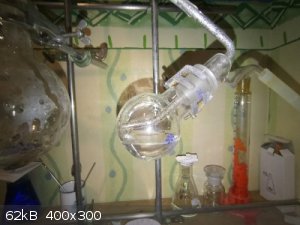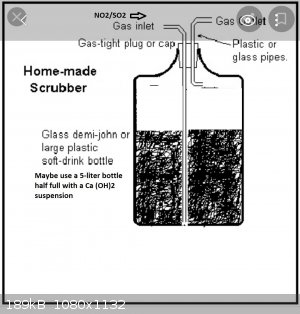Zincmish
Harmless

Posts: 4
Registered: 18-7-2019
Member Is Offline
|
|
Taking care of SO2 and NO2
Hello! I 'm new to this forum (although was a passive reader for years)
I have to design a chem demo where we have to obtain a few ml of H2SO4 by the sodium metabisulfite method. The problem is that an uncontrollable
amount of SO2 and NO2 is generated, and can be dangerous even if i use a proper fume hood.
I was wondering if there is any way to remove, reduce or absorb those. I was thinking in building a sort of homemade absorbent scrubber with a
suspension of Ca(OH)2 or CaCO3; but I'm not sure if it could work.
If anyone knows of a way to make this practice safer, that would be great. Thank you!
|
|
|
itsallgoodjames
Hazard to Others
  
Posts: 276
Registered: 31-8-2020
Location: America Lite
Member Is Offline
|
|
Bubbling the gases through a saturated solution of sodium hydroxide in a tall tube such as a graduated cylinder should turn them into sodium sulfite
and nitrate. This is how I usually neutralize NO2, and I don't see a reason it wouldn't work for SO2
Nuclear physics is neat. It's a shame it's so regulated...
Now that I think about it, that's probably a good thing. Still annoying though.
|
|
|
woelen
Super Administrator
        
Posts: 7976
Registered: 20-8-2005
Location: Netherlands
Member Is Offline
Mood: interested
|
|
I do not see how this is dangerous in a properly working fume hood. I understand that you want to make a small amount of H2SO4 from SO2 and NO2 by
mixing these with water? You only need to make 250 ml or so of both gases. Use syringes to blow these gases in an empty liter bottle (hence: filled
with air) and then add 10 ml of water to this. Close the bottle and swirl the water. SO2 and NO2 are absorbed and you get (impure) H2SO4 in the
bottle. You then can test its acidity and with a barium salt you can show that there is sulfate in it.
If you make some SO2 and NO2, e.g. a big erlenmeyer full of these gases and take these out, using a syringe, and you do all of this manipulation in a
fume hood, then I see no safety problems.
|
|
|
mackolol
Hazard to Others
  
Posts: 458
Registered: 26-10-2017
Member Is Offline
Mood: Funky
|
|
Suspension of Ca(OH)2 or CaCO3 might not be enough. I would personally go for something much more soluble in water, yet easy to obtain and cheap just
like Na2CO3 or NaHCO3.
|
|
|
itsallgoodjames
Hazard to Others
  
Posts: 276
Registered: 31-8-2020
Location: America Lite
Member Is Offline
|
|
NaOH works great, and is cheaply available as drain opener. I've also found references that say it works for SO2 as well as NO2. I've used it for
NO2 extensively in the past, and it should work for SO2 as well
Nuclear physics is neat. It's a shame it's so regulated...
Now that I think about it, that's probably a good thing. Still annoying though.
|
|
|
Zincmish
Harmless

Posts: 4
Registered: 18-7-2019
Member Is Offline
|
|
Thanks!
The yield -as a reference- is about 400 ml of 70% sulfuric acid (after evaporating to concentrate), however in my first attempts I generated so many
acid gases that the hood was not enough (it is not a new hood either).
I tried bubbling in a small NaOH column as you suggest, but it was not enough ... several papers claim that Ca (OH) 2 and CaCO3 can be effective. Si
i'll try with them.
I'm planning to buble those on a 5 lts plastic containter half filled with Ca(OH2) suspension. The size of the column I must have is not well
calculated either so i'm not sure if that could work.
|
|
|
teodor
National Hazard
   
Posts: 872
Registered: 28-6-2019
Location: Heerenveen
Member Is Offline
|
|
If you concern about safety I would spit the process into 2 parts:
1. Preparing SO2 solution in water.
2. Gas it with NO2.
I think this should be much simpler than managing streams of 2 gases simultaneously.
The water could be stored in a freezer as an ice. You can use any plastic bottle, it doesn't expand when saturated with SO2 by the way.
NO2 usually could not be bubbled into solution because it sucks the solution back. In hermetic system (glass joints sealed with H2SO4) I can work with
it without any hood, this gas is not very mobile, so using a hood should be more than enough and you can scrub it like on the picture (just with
water). Before this point all pipes are glass or FEP.

I think the most important is to manage the gas generation speed. If you can do it I doubt even you need additional scrubber for NO2 except the
reaction vessel.
If you have some leak just use a spray bottle to spray the contaminated space with water, it will absorb NO2.
[Edited on 18-12-2020 by teodor]
|
|
|
valeg96
Hazard to Others
  
Posts: 253
Registered: 6-4-2014
Location: Italy
Member Is Offline
Mood: Moodless
|
|
@woelen Where I currently am the hoods are checked an working properly, but the system as a whole is somehow flawed and what gets drawn up on top
floors is sometimes released by hoods on the lower floors. Learned this when I was asked to neutralise and dispose of some degraded acryloyl chloride
and one of the floors below was evacuated because they couldn't figure out where the stench was coming from...
So I can see why even if the hood is working fine OP would rather not have a huge amount of NOx
|
|
|
Zincmish
Harmless

Posts: 4
Registered: 18-7-2019
Member Is Offline
|
|
| Quote: |
@woelen Where I currently am the hoods are checked an working properly, but the system as a whole is somehow flawed and what gets drawn up on top
floors is sometimes released by hoods on the lower floors. Learned this when I was asked to neutralise and dispose of some degraded acryloyl chloride
and one of the floors below was evacuated because they couldn't figure out where the stench was coming from...
So I can see why even if the hood is working fine OP would rather not have a huge amount of NOx
|
Exactly my concern ... I don't want the labs below evacuated because of me, 
The other times I made it, the performance was good, but 'cause of those two gases (even the dense NO2) this demo becames a very messy (and smelly)
one...
Let me explain more...
In those first attemps I used a solution of concentrated NaOH a washing bottle and then a bigger graduater cylinder...I do not know why, but bubling
in concentrated NaOH did not work at all.
Then i thought that SO2 and NO2 are a quite common waste by-product in industrial processes so there should be many effective ways of safely chemisorb
those.... Many sources claim Ca(OH)2 and CaCO3 are used on some scrubber systems to clean flows with those two.
Then I switched to a Ca(OH)2 suspension and everything started to go wonderfully ... until suddenly the gas outlet overflowed, bathing all of the
suspension around. Nice view.
Maybe using a larger container like 5 liters will be effective.I don't know...maybe by forcing the exhaust gases out with some cheap pump.
[Edited on 18-12-2020 by Zincmish]
|
|
|
valeg96
Hazard to Others
  
Posts: 253
Registered: 6-4-2014
Location: Italy
Member Is Offline
Mood: Moodless
|
|
I assume it didn't work properly because the specific surface of the bubbles is not big enough. You need to get one or multiple fritted glass washing
bottles or inlet tubes so the stream of gas is divided into very fine bubbles. I don't have a fumehood and whenever I work with NOx those fritted
glass bubblers are always a must, otherwise the gas won't be neutralised.
|
|
|
teodor
National Hazard
   
Posts: 872
Registered: 28-6-2019
Location: Heerenveen
Member Is Offline
|
|
Quote: Originally posted by Zincmish  |
In those first attemps I used a solution of concentrated NaOH a washing bottle and then a bigger graduater cylinder...I do not know why, but bubling
in concentrated NaOH did not work at all.
[Edited on 18-12-2020 by Zincmish] |
I assume it was NO who escaped NaOH. It doesn't actively react with alkalies. Then it goes outside your apparatus, attaches oxygen and converts itself
into NO2 again.
|
|
|
Zincmish
Harmless

Posts: 4
Registered: 18-7-2019
Member Is Offline
|
|
| Quote: |
I assume it was NO who escaped NaOH. It doesn't actively react with alkalies. Then it goes outside your apparatus, attaches oxygen and converts itself
into NO2 again.
|
Not sure why, but even SO2 bubbled out the NaOH solution (easily identifiable). Maybe NaOH solution is not good absorbing for those two gases at the
same time.
I guess I'll go with some like this :

|
|
|
Texium
|
Thread Moved
19-12-2020 at 09:38 |
Fyndium
International Hazard
    
Posts: 1192
Registered: 12-7-2020
Location: Not in USA
Member Is Offline
|
|
Strong NaOH solution does little to absorb NO2 by my experience that caused a major issue when I did a reaction which released not huge but pretty
amounts of it. It just bubbled through the inverted funnel trap like nothing.
NO forms NO2 readily in air, so if decent amounts of it are formed, it will turn into new trouble. This is clearly noticeable when the system is under
airlock, it is clear, but instantly when air is allowed to enter, the system turns reddish brown as it oxidizes.
My only good solution was to directly vent off the gas into the exhaust duct. This is not possible in all circumstances, though.
|
|
|